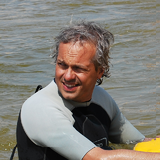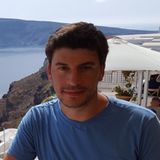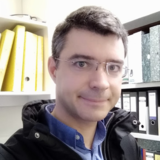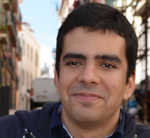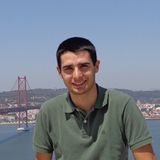Difference between revisions of "Hall of fame"
| (9 intermediate revisions by 2 users not shown) | |||
| Line 1: | Line 1: | ||
| − | ==e-lab geeks== | + | <!-- ==e-lab geeks== --> |
On this page, we try to collect all nerd contributors to e-lab who have helped in any way to put this project in shape and try to digest their own personal interests. | On this page, we try to collect all nerd contributors to e-lab who have helped in any way to put this project in shape and try to digest their own personal interests. | ||
| Line 15: | Line 15: | ||
==Ivo Carvalho== | ==Ivo Carvalho== | ||
<!--Thompson--> | <!--Thompson--> | ||
| + | [[File:Ivo biopic.jpg||right|160px]] | ||
| + | Ivo Carvalho received the B.S., M.S. and Ph.D. degrees in physics engineering from Instituto Superior Tecnico, Portugal, in 2004, 2008 and 2013, respectively. As an e-lab collaborator, he developed the Remote Thomson experiment. His scientific research started in 2004 in the real-time control and data acquisition area and with time his scientific interests expanded to the areas of machine operation and discharge performance optimisation. Some scientific highlights include the extension of the ISTTOK tokamak alternate current discharges beyond one second of operation and the operation the JET tokamak as fully qualified session leader. He is a member of the JET plasma operations group since 2014 as a secondee from IST. (last updated March/2019) | ||
==João Fortunato== | ==João Fortunato== | ||
| Line 22: | Line 24: | ||
<!--dsPIC migration--> | <!--dsPIC migration--> | ||
| − | == | + | ==João Figueiredo== |
| + | I got my PhD on Pellet Physics Studies using MAST Thomson Scattering Diagnostic in 2013. Currently (2019) I’m the responsible for upgrades to data acquisition systems, instrumentation and enhancements at JET. In this capacity I’ve coordinated more than 30 projects deploying at JET new or upgrades to diagnostics across the full range of technologies and methods used in Nuclear Fusion. I developed and installed the initial e-lab meteorological station and provided support to several other experiments. | ||
==Pedro Carvalho== | ==Pedro Carvalho== | ||
<!--Dice statistics--> | <!--Dice statistics--> | ||
| + | [[File:Pcarvalho_biopic.png||right|160px]] | ||
| + | Got my PhD on Fast Tomographic Algorithms for Real-Time Applications at IPFN, with application to ISTTOK and currently (2018) working at JET as Responsible Officer for the Bolometer system and Tomography processing and validation. I have worked on the implementation of the Infra-red protection camera system for the ITER-like Wall (ILW) at JET and have become an expert Operator of this System, participating in most JET experimental campaigns since the ILW was installed. I have also been involved with the development of a program that processed FM Microwave Reflectometry data to produce electron density profiles at JET and ASDEX-Upgrade; and was a part of the team that implemented the interface between ASDEX's real-time control software and the lower plant level, MARTe framework that is planned to operate on some control systems at ITER. Had also a collaboration in tomography algorithms for Wendelstein7-X and fast camera image analysis at TJ-II. | ||
| + | Developed the Aleatorio experiment during e-lab's first few years, as the thesis of the Graduate Degree in Physics Engineering. It consists of an apparatus that shuffles some dice and takes a picture of the result and then counts the spots, gathering statistics with every throw. | ||
==André Neto== | ==André Neto== | ||
| Line 45: | Line 51: | ||
==João Loureiro== | ==João Loureiro== | ||
[[File:photo-joao1.png||right|160px]] | [[File:photo-joao1.png||right|160px]] | ||
| − | A native of Lisbon, João studied at IST where he got the MSc Degree in Engineering Physics. He has always had a strong interest in experimental physics, and in particular in plasmas and fusion. This eventually became his field of work when he started collaborating with e-lab during his BSc degree. What started as course's final project | + | A native of Lisbon, João studied at IST where he got the MSc Degree in Engineering Physics. He has always had a strong interest in experimental physics, and in particular in plasmas and fusion. This eventually became his field of work when he started collaborating with e-lab during his BSc degree. What started as course's final project, evolved into a master project where two Plasma-themed e-lab experiments where developed: Langmuir probe and the Paschen Curve experiments. |
When he's not maintaining the Langmuir probe experiment he is working with magnetically confined nuclear fusion devices in IPFN in the context of his PhD. | When he's not maintaining the Langmuir probe experiment he is working with magnetically confined nuclear fusion devices in IPFN in the context of his PhD. | ||
| Line 55: | Line 61: | ||
==Samuel Balula== | ==Samuel Balula== | ||
| − | <!--Colisione--> | + | <!--Colisione |
| + | Eu colaborei entre 2012 e 2016, tendo participado nas seguintes | ||
| + | experiências: | ||
| + | - pêndulo mundial | ||
| + | - colisão elástica (colisione) | ||
| + | - lei de hook (mola) | ||
| + | - hidroestática | ||
| + | |||
| + | código: | ||
| + | e-lab’s rec generic driver for arduino | ||
| + | |||
| + | Quanto a artigos, o mais facil é veres aqui: | ||
| + | https://orcid.org/0000-0002-7384-3848 | ||
| + | --> | ||
| + | [[File:foto_Samuel_Balula.jpg||right|160px]] | ||
==Pedro Black== | ==Pedro Black== | ||
Latest revision as of 16:14, 29 May 2019
On this page, we try to collect all nerd contributors to e-lab who have helped in any way to put this project in shape and try to digest their own personal interests.
Contents
- 1 Horácio Fernandes
- 2 José Pedro Pereira
- 3 Ivo Carvalho
- 4 João Fortunato
- 5 Leonardo Pedro
- 6 João Figueiredo
- 7 Pedro Carvalho
- 8 André Neto
- 9 Josué Lopes
- 10 Tiago Pereira
- 11 Hugo Alves
- 12 Rafael Henriques
- 13 André Duarte
- 14 João Loureiro
- 15 Rui Figueiredo
- 16 Ruben Marques
- 17 Samuel Balula
- 18 Pedro Black
- 19 Miguel Batista
- 20 Manuel Santos
- 21 Ruben Valentim Cardoso
- 22 Rui Dias
Horácio Fernandes
Presently I'm an associate professor of the IST's physics department, teaching Micro-controllers, Real-time Control and Electronic and Optics Instrumentation as main courses, besides general physics.
I've created e-lab in the past as an incentive for master students to develop their studies in electronic instrumentation which some of them succeed in publish it as their Master Thesis. By that time I didn't know that this field of science would become what is known presently by IoT.
My scientific research is focused on nuclear fusion devices specifically on (i) diagnostics, (ii) real-time control and (iii) tokamak operation.
José Pedro Pereira
Ivo Carvalho
Ivo Carvalho received the B.S., M.S. and Ph.D. degrees in physics engineering from Instituto Superior Tecnico, Portugal, in 2004, 2008 and 2013, respectively. As an e-lab collaborator, he developed the Remote Thomson experiment. His scientific research started in 2004 in the real-time control and data acquisition area and with time his scientific interests expanded to the areas of machine operation and discharge performance optimisation. Some scientific highlights include the extension of the ISTTOK tokamak alternate current discharges beyond one second of operation and the operation the JET tokamak as fully qualified session leader. He is a member of the JET plasma operations group since 2014 as a secondee from IST. (last updated March/2019)
João Fortunato
Leonardo Pedro
João Figueiredo
I got my PhD on Pellet Physics Studies using MAST Thomson Scattering Diagnostic in 2013. Currently (2019) I’m the responsible for upgrades to data acquisition systems, instrumentation and enhancements at JET. In this capacity I’ve coordinated more than 30 projects deploying at JET new or upgrades to diagnostics across the full range of technologies and methods used in Nuclear Fusion. I developed and installed the initial e-lab meteorological station and provided support to several other experiments.
Pedro Carvalho
Got my PhD on Fast Tomographic Algorithms for Real-Time Applications at IPFN, with application to ISTTOK and currently (2018) working at JET as Responsible Officer for the Bolometer system and Tomography processing and validation. I have worked on the implementation of the Infra-red protection camera system for the ITER-like Wall (ILW) at JET and have become an expert Operator of this System, participating in most JET experimental campaigns since the ILW was installed. I have also been involved with the development of a program that processed FM Microwave Reflectometry data to produce electron density profiles at JET and ASDEX-Upgrade; and was a part of the team that implemented the interface between ASDEX's real-time control software and the lower plant level, MARTe framework that is planned to operate on some control systems at ITER. Had also a collaboration in tomography algorithms for Wendelstein7-X and fast camera image analysis at TJ-II. Developed the Aleatorio experiment during e-lab's first few years, as the thesis of the Graduate Degree in Physics Engineering. It consists of an apparatus that shuffles some dice and takes a picture of the result and then counts the spots, gathering statistics with every throw.
André Neto
Josué Lopes
Tiago Pereira
Hugo Alves
Rafael Henriques
André Duarte
João Loureiro
A native of Lisbon, João studied at IST where he got the MSc Degree in Engineering Physics. He has always had a strong interest in experimental physics, and in particular in plasmas and fusion. This eventually became his field of work when he started collaborating with e-lab during his BSc degree. What started as course's final project, evolved into a master project where two Plasma-themed e-lab experiments where developed: Langmuir probe and the Paschen Curve experiments. When he's not maintaining the Langmuir probe experiment he is working with magnetically confined nuclear fusion devices in IPFN in the context of his PhD.
